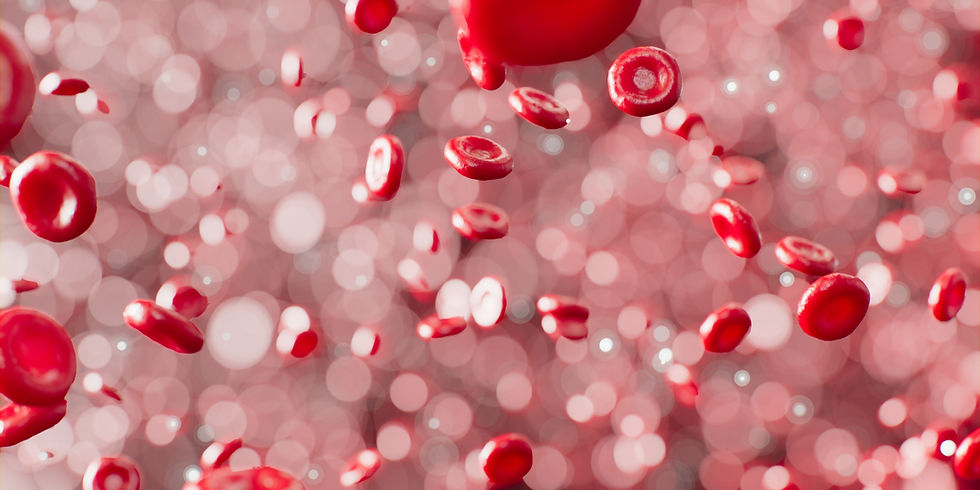- Katharina Butsch
- Apr 20
- 4 min read
Updated: May 4

Roller coaster in the blood - understanding and preventing blood sugar level fluctuation
It is now pretty well known that strong blood sugar fluctuations are not great for your health. But what drives blood sugar fluctuations in healthy people and how can they be limited?
Fluctuating blood sugar levels - What you should know
First of all, blood sugar specifically refers to the amount of glucose in the blood. As a reminder: Glucose is the smallest structural unit of carbohydrates such as starch and disaccharides like table sugar or lactose. To absorb these carbohydrates from food, starch and disaccharides must be broken down into their building blocks, the simple sugars such as glucose. These simple sugars are then absorbed from the intestine and transported via the blood to the various tissues and organs, where they are metabolized. In case of glucose, this primarily is the energy metabolism.
This shows, blood sugar fluctuations are normal and even necessary for a functioning carbohydrate metabolism: On the one hand, the blood sugar level is raised through the intake of food and falls through the use of glucose in the body. On the other hand, the blood sugar level serves as a regulator for energy distribution in the body. The goal is to ensure that all tissues are supplied with energy from glucose according to their importance. Less important tissues such as fat tissue, where energy is stored, or muscle tissue, where energy is converted to movement should only obtain energy from blood glucose, if vital tissues like brain cells, are already supplied adequately. Here insulin is key: it is always released when blood sugar levels are high, indicating high energy availability. Fat cells and muscle cells can only absorb glucose from the blood if insulin is present. When blood sugar levels are low, insulin is not released and muscles and fatty tissue cannot take glucose from the blood.
Things become unhealthy when the body is supplied with too much energy over a long time and the blood sugar level is permanently elevated. This has almost become the norm with our current lifestyle. And this is why it’s interesting to see how blood sugar levels are affected by eating different foods.
The influence of food on blood sugar levels
The level of blood sugar after a meal depends on the total carbohydrate intake as well as the food’s composition. We differentiate foods with a so-called high and low glycemic index ( abbreviated GI).

Foods with a high glycemic index cause blood sugar levels to rise quickly and to a high level. Such an increase is followed by an intense insulin response, which induces a quick absorption of glucose from the blood into muscles and fat cells. In turn, the blood sugar level drops rapidly after a short time. This results in a quick return of hunger, or even cravings. Foods with a low glycemic index however, raise blood sugar levels only slowly and to a lower extent as foods with a high glycemic index. The subsequent insulin release is less strong and blood sugar levels fall much more slowly. Foods with a low glycemic index therefore fill you up for longer. Slightly fluctuating blood sugar levels therefore lead to a more balanced energy supply. A “stable” blood sugar level is thus desirable.
Now, which foods have a high glycemic index and which have a low one? The answer is easy to derive: it depends on the glucose availability from this food. The more glucose a food contains overall, the larger its influence on blood sugar levels.
If glucose is additionally contained as mono- or disaccharides in the food, breakdown and absorption occur quickly in the intestine and the blood sugar level rises quickly to high levels. However, if glucose is primarily present as complex carbohydrates like starch, these must first be broken down before glucose can be absorbed from the intestine. This process takes time and delays the increase of blood sugar levels. The resulting increase is slow, stops at a lower level and stays high over a longer period of time.
Foods with a high glycemic index contain a lot of free sugars and few complex carbohydrates. Examples are sweets, sodas or white bread. Foods with a low glycemic index contain mostly complex carbohydrates. Examples include raw vegetables, lentils or whole grain bread.
Other food components also influence blood sugar levels: proteins and fats delay the release of insulin and thereby prevent a rapid drop in blood sugar levels. Fibers slow down blood sugar level increase by promoting a gel-like consistency of the food mix in the intestines from which glucose cannot be absorbed as quickly.
5 nutrition tips for stable blood sugar
Consume ~50% max. of your daily energy as carbohydrates
Choose foods with a low glycemic index, i.e. low in free sugars and high in complex carbohydrates
If possible, do not consume carbohydrates alone, but combine them with proteins and fats
Eat enough fiber (approx. 30 g per day)
Limit your consumption of liquid food like smoothies and shakes, since glucose can be quickly absorbed from them


